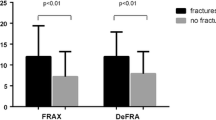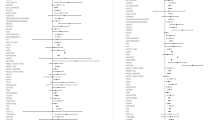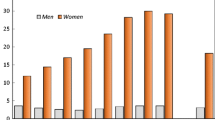Abstract
While estimates of relative risks associated with risk factors such as age and bone mineral density (BMD) may be of interest for etiologic and comparative purposes, clinical questions such as who might benefit most from preventive interventions or BMD monitoring depend on estimates of absolute fracture risk. The European prospective investigation into cancer (EPIC)-Norfolk study included 25,311 participants (11,476 men) aged 4,079 years in 1993–1997. All participants were followed for osteoporotic fractures to March 2007. Ten-year absolute risk of fracture in men and women were calculated using the baseline survivor function in multivariable Cox proportional-hazards models adjusting for age, sex, history of fractures, body mass index, smoking, and alcohol intake. In comparison of those without history of fracture versus those with history of fracture, the 10-year absolute risk of any fracture in men ranged from 1.0 vs. 1.2% at age 40 years to 3.0 vs. 4.4% at age 75 years. The respective estimates in women ranged from 0.7 vs. 1.0% at age 40 years to 9.3 vs. 17.2% at age 75 years. Statistically significant interaction between age and sex was found (P < 0.001), which contributed to the differences in predicted absolute fracture risks for men and women at different ages. Our study shows the need for population-specific data to develop efficient well calibrated algorithms for assessment of fracture risk. The interaction observed between sex and age points to the need for further prospective studies among men.


Similar content being viewed by others
Abbreviations
- BMD:
-
Bone mineral density
- EPIC:
-
European prospective investigation into cancer
- WHO:
-
World Health Organization
- ICD:
-
International classification of diseases
References
Kanis JA, Johnell O, Oden A, Dawson A, De Laet C, Jonsson B. Ten year probabilities of osteoporotic fractures according to BMD and diagnostic thresholds. Osteoporos Int. 2001;12:989–95. doi:10.1007/s001980170006.
Tucker G, Metcalfe A, Pearce C, Need AG, Dick IM, Prince RL, et al. The importance of calculating absolute rather than relative fracture risk. Bone. 2007;41:937–41. doi:10.1016/j.bone.2007.07.015.
Siminoski K, Leslie WD, Frame H, Hodsman A, Josse RG, Khan A, et al. Recommendations for bone mineral density reporting in Canada. Can Assoc Radiol J. 2005;56:178–88.
Kanis JA, Borgstrom F, De Laet C, Johansson H, Johnell O, Jonsson B, et al. Assessment of fracture risk. Osteoporos Int. 2005;16:581–9. doi:10.1007/s00198-004-1780-5.
Leslie WD, Metge C, Ward L. Contribution of clinical risk factors to bone density-based absolute fracture risk assessment in postmenopausal women. Osteoporos Int. 2003;14:334–8. doi:10.1007/s00198-003-1375-6.
Cummings SR, Bates D, Black DM. Clinical use of bone densitometry: scientific review. JAMA. 2002;288:1889–97. doi:10.1001/jama.288.15.1889.
De Laet C, Oden A, Johansson H, Johnell O, Jonsson B, Kanis JA. The impact of the use of multiple risk indicators for fracture on case-finding strategies: a mathematical approach. Osteoporos Int. 2005;16:313–8. doi:10.1007/s00198-004-1689-z.
Ettinger B, Hillier TA, Pressman A, Che M, Hanley DA. Simple computer model for calculating and reporting 5-year osteoporotic fracture risk in postmenopausal women. J Womens Health (Larchmt). 2005;14:159–71. doi:10.1089/jwh.2005.14.159.
Melton LJIII, Johnell O, Lau E, Mautalen CA, Seeman E. Osteoporosis and the global competition for health care resources. J Bone Miner Res. 2004;19:1055–8. doi:10.1359/JBMR.040316.
Kanis JA. World Health Organization Scientific Group. Assessment of osteoporosis at the primary health-care level. Technical Report. UK: World Health Organization Collaborating Center for Metabolic Bone Disease, University of Sheffield; 2007.
Kanis JA, Johnell O, Oden A, Johansson H, McCloskey E. FRAX and the assessment of fracture probability in men and women from the UK. Osteoporos Int. 2008;19:385–97. doi:10.1007/s00198-007-0543-5.
Cooper C, Campion G, Melton LJIII. Hip fractures in the elderly: a world-wide projection. Osteoporos Int. 1992;2:285–9. doi:10.1007/BF01623184.
Schwartz AV, Kelsey JL, Maggi S, Tuttleman M, Ho SC, Jonsson PV, et al. International variation in the incidence of hip fractures: cross-national project on osteoporosis for the World Health Organization Program for research on aging. Osteoporos Int. 1999;9:242–53. doi:10.1007/s001980050144.
Kannus P, Parkkari J, Sievanen H, Heinonen A, Vuori I, Jarvinen M. Epidemiology of hip fractures. Bone. 1996;18:57S–63S. doi:10.1016/8756-3282(95)00381-9.
Cooper C. Epidemiology and public health impact of osteoporosis. Baillieres Clin Rheumatol. 1993;7:459–77. doi:10.1016/S0950-3579(05)80073-1.
Day N, Oakes S, Luben R, Khaw KT, Bingham S, Welch A, et al. EPIC-Norfolk: study design and characteristics of the cohort. European Prospective Investigation of Cancer. Br J Cancer. 1999;80(Suppl 1):95–103.
Cox DR, Oakes D. Analysis of survival data. London: Chapman and Hall; 1984.
Royston P, Ambler G, Sauerbrei W. The use of fractional polynomials to model continuous risk variables in epidemiology. Int J Epidemiol. 1999;28:964–74. doi:10.1093/ije/28.5.964.
Harrell FE Jr, Lee KL, Califf RM, Pryor DB, Rosati RA. Regression modelling strategies for improved prognostic prediction. Stat Med. 1984;3:143–52. doi:10.1002/sim.4780030207.
Hosmer DW, Lemeshow S. Applied survival analysis. New York: Wiley; 1999.
Nguyen ND, Frost SA, Center JR, Eisman JA, Nguyen TV. Development of a nomogram for individualizing hip fracture risk in men and women. Osteoporos Int. 2007;18:1109–17. doi:10.1007/s00198-007-0362-8.
Nguyen ND, Ahlborg HG, Center JR, Eisman JA, Nguyen TV. Residual lifetime risk of fractures in women and men. J Bone Miner Res. 2007;22:781–8. doi:10.1359/jbmr.070315.
Abrahamsen B, Vestergaard P, Rud B, Barenholdt O, Jensen JE, Nielsen SP, et al. Ten-year absolute risk of osteoporotic fractures according to BMD T score at menopause: the Danish osteoporosis prevention study. J Bone Miner Res. 2006;21:796–800. doi:10.1359/jbmr.020604.
Kanis JA, Johnell O, De Laet C, Jonsson B, Oden A, Ogelsby AK. International variations in hip fracture probabilities: implications for risk assessment. J Bone Miner Res. 2002;17:1237–44. doi:10.1359/jbmr.2002.17.7.1237.
Marshall D, Johnell O, Wedel H. Meta-analysis of how well measures of bone mineral density predict occurrence of osteoporotic fractures. BMJ. 1996;312:1254–9.
Kanis JA, Oden A, Johnell O, Johansson H, De Laet C, Brown J, et al. The use of clinical risk factors enhances the performance of BMD in the prediction of hip and osteoporotic fractures in men and women. Osteoporos Int. 2007;18:1033–46. doi:10.1007/s00198-007-0343-y.
Richards JB, Leslie WD, Joseph L, Siminoski K, Hanley DA, Adachi JD, et al. Changes to osteoporosis prevalence according to method of risk assessment. J Bone Miner Res. 2007;22:228–34. doi:10.1359/jbmr.061109.
Leslie WD, Siminoski K, Brown JP. Comparative effects of densitometric and absolute fracture risk classification systems on projected intervention rates in postmenopausal women. J Clin Densitom. 2007;10:124–31. doi:10.1016/j.jocd.2007.01.003.
Jackson SA, Tenenhouse A, Robertson L. Vertebral fracture definition from population-based data: preliminary results from the Canadian Multicenter Osteoporosis Study (CaMos). Osteoporos Int. 2000;11:680–7. doi:10.1007/s001980070066.
Leslie WD, Metge C. Establishing a regional bone density program: lessons from the Manitoba experience. J Clin Densitom. 2003;6:275–82. doi:10.1385/JCD:6:3:275.
Khaw KT, Reeve J, Luben R, Bingham S, Welch A, Wareham N, et al. Prediction of total and hip fracture risk in men and women by quantitative ultrasound of the calcaneus: EPIC-Norfolk prospective population study. Lancet. 2004;363:197–202. doi:10.1016/S0140-6736(03)15325-1.
Acknowledgments
EPIC-Norfolk is supported by program grants from the Medical Research Council and Cancer Research UK with additional support from the Stroke Association, Research into Ageing, the Academy of Medical Sciences, British Heart Foundation, Department of Health, and the Wellcome Trust. The sponsors had no role in the design and conduct of the study, collection, management, analysis and interpretation of the data, and preparation, review or approval of the manuscript.
Conflict of interest statement
All authors declare that they have no conflict of interest in conducting this study and publication of the results.
Author information
Authors and Affiliations
Corresponding author
Rights and permissions
About this article
Cite this article
Moayyeri, A., Kaptoge, S., Luben, R.N. et al. Estimation of absolute fracture risk among middle-aged and older men and women: the EPIC-Norfolk population cohort study. Eur J Epidemiol 24, 259–266 (2009). https://doi.org/10.1007/s10654-009-9337-8
Received:
Accepted:
Published:
Issue Date:
DOI: https://doi.org/10.1007/s10654-009-9337-8




